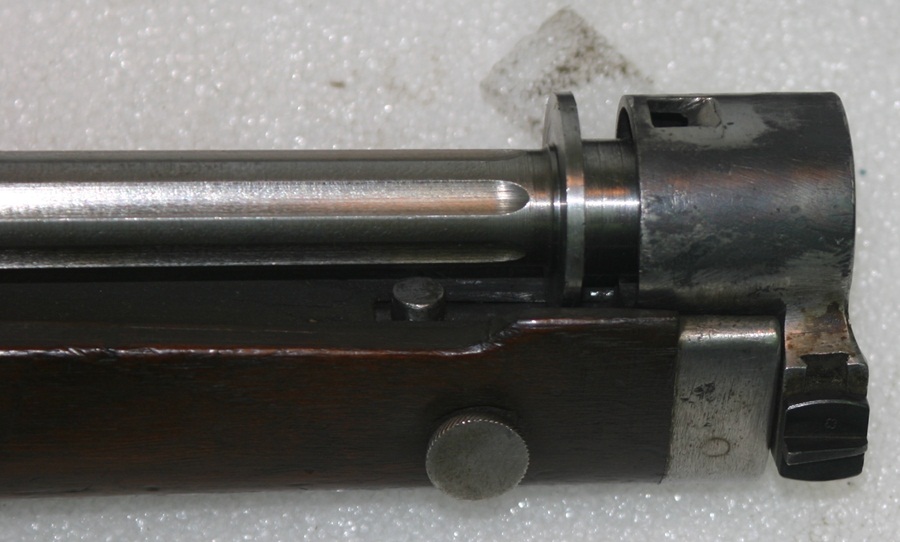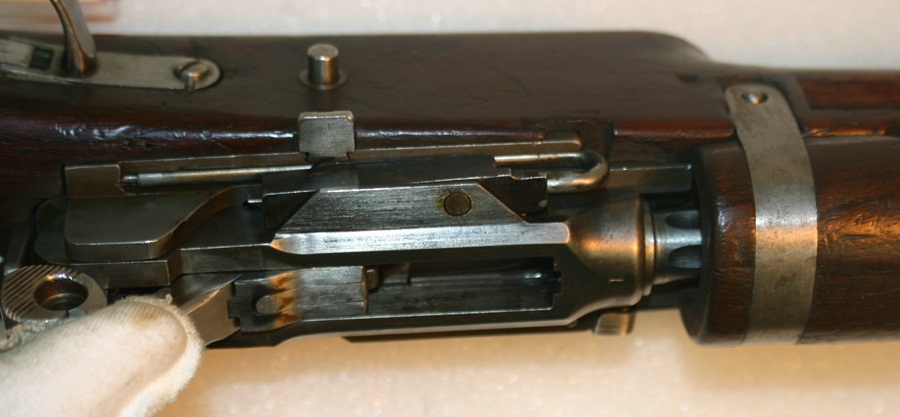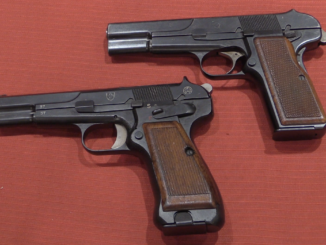We’ve mentioned that Adolf Furrer (director of Waffenfabrik Bern) began his career making Lugers and Maxims, which helps explain his obsession with toggle locks. Well, before he developed his own take on the mechanism for the LMG25, he experimented with using stock Luger actions for developing a submachine gun. The result was built in small numbers in 1919, and we found a prototype of the model to take a look at in the British NFC collection:

We have had very little success finding information on this submachine gun – there appears to be very little written about it in English. What we do know is that it is based around a Luger slide and toggle that are pretty much unmodified. The action is rotated 90 degrees to feed from the right and eject out the left, and the lower frame of the pistol has been replaced by a bulkier frame to support a stock and large magazine (most likely 30 or 40 rounds of 7.65 Luger). The barrel still reciprocates back like a Luger, and the muzzle has a gas booster built in to help accelerate the longer and heavier barrel backwards (much like a Maxim or Vickers).


This gun is an interesting idea, but completely unsuited for practical use. It’s really bulky, front heavy (and heavy in general), and has all the same shortcomings as the Luger pistol but magnified by the expectation of sustained automatic fire. Judging from the very few photos we found of the production version of the MP1919, not much was changed after this prototype (note the serial number “1” on the action) was made.
We have a bunch more photos, which you can see here, and on the Furrer MP1919 page in the Vault (click here to download the gallery as a high-res archive). If anyone has more information on the gun, we would love to hear from you!
[nggallery id=154]



That is interesting,
Not that I’d like to fire it without a pair of pilot’s goggles to keep any hot particles coming out of that left side ejection port away from my eyes!
The early ideas about SMGs/Carbines/machinepistols are fascinating
The whole mass of ideas which came out about what the calibre should be, what the size and type of action, whether it fitted the role of pistol, of light handy carbine or of light version of a heavy machinegun.
Although very much a Frankenstein’s monster of Luger bits, the (wrong) side ejection, side mounted mag, and recoil intensifyer all make for a more practical gun than a Luger carbine or artillery Luger
Or for that matter, any of the numerous German and Spanish selective fire pistols.
Furrer was certainly not the only person with a Swiss connection, who was working on locked breech pistol based SMGs
Charles G Petter (who’s work forms the basis of the SIG P210 pistol) also held patents for a carbine with a Browning 1911 style tilting barrel, along with a watch escapment inspired rate of fire reducer.
I’m sure I had a copy of a US patent for it, but I can only find the French language ones on the net: http://worldwide.espacenet.com/publicationDetails/biblio?FT=D&date=19381115&DB=EPODOC&locale=en_EP&CC=CH&NR=201033A&KC=A&ND=4
CH201033 (A) ― 1938-11-15
Great job this week, Ian. Every post was so informative. I have two of Ian Hogg’s books (Military Small Arms of the 20th Century and Machine Guns) and in both he does a terrible job explaining the workings of the Furrer guns. He mentions that Furrer designed a 37mm anti-tank gun using this action. Have you (or anyone else) any info on that particular beast?
Thanks, Al. Unfortunately, I don’t know anything about a Furrer-style 37mm gun.
I’ve fixed the link to the high-res photo zip file.
Thanks for the Lead Al,
Chinn, The Machinegun, vol 1 has the machinegun on page 425, and the cannons from page 591.
Scans of all of the volumes of Chinn’s books are up on SRIBD.
They’re where the likes of Smith got any reliable info found in his books from (pretty much word for word, then whether for the sake of national secrecy or for his own ego, he didn’t cite the source.
Seems there were 2 models of cannon, a 20mm for firing out of the prop axis of a Hispano Suiza engine, and a 34mm for wing, turret and synchronized mounting. Firing was slightly before the toggle was fully down, but it was still over centre, this allowed some buffering of the recoil cycle and speeded the cyclic rate, given as 350 RPM.
Belts were steel, non disintegrating, and from either side. The belt feed could be disengaged to allow the bolt forward on an empty chamber. all models incorporated a shot counter!
Chinn says that the Furrer models were all made at the Government arsenals, Oerlikon and Hispano Suiza made their own designs (hardly surprising – I don’t think they’d break even on a furrer design – they’re for wasting tax payer’s money on, rather than rewarding shareholders).
Correction; the toggle was fully closed, but the barrel had not returned fully to battery for subsequent shots, so the recoil had first to slow the forward movement of the barrel and action.
Chinn has many interesting anecdotes about the guns. It seems that for barrel changes, both the barrel and toggle mechanism were changed as a unit.
Barrels for the machine guns (presumably both the 7.5mm and 13mm )were made of a special alloy steel and given special heat treatment, the Swiss claimed a life of 25,000 rounds. French testing showed 18,000 rounds without detectable loss of accuracy or wear!
Chinn also describes the reworking of worn out rifle barrels into liners for re-lining machinegun barrels, in anticipation of wartime shortages of steel.
Furrer’s patent for the action is US1518498
There are other patents, apparently for a combined muzzle break and intensifyer, allong with some sort of lock or tripping mechanism in the receiver. I don’t read German: http://worldwide.espacenet.com/publicationDetails/biblio?DB=EPODOC&II=3&ND=3&adjacent=true&locale=en_EP&FT=D&date=19460315&CC=CH&NR=241437A&KC=A
Chinn quotes rates of fire for the 7.5mm with the larger intensifier and stronger buffer spring of 1200/minute.
Chinn, vol 1
http://www.scribd.com/doc/44252286/The-Machine-Gun-Vol-1-G-Chinn-US-Navy-BuOrd-1951-WW
Thanks Keith. While we’re on the subject of Chinn’s masterpiece, the whole thing (save for volume 2) is available here: .
Darn!!! Here is the link again: http://www.ibiblio.org/hyperwar/USN/ref/MG/
By the way, I am in no way affiliated with the website. I just think it is a fantastic reference.
Many thanks Al, having it in HTML text is a lot nicer to read than grainy scans, and the big clear scans of the photos are nice too.
I only discovered Chinn a couple of years back, and liked it so much that I splashed out on a proper paper copy of Vol 4, but I really am nerdy like that 😉
There were some very good scans of things like Hatcher’s notebook, and genuine gunsmithing books like Vickery (as opposed to books on bubbaficating) at a place called “Steve’s Pages”, but I’m very wary of recommending it or visiting it myself (I’m in Britain these days), as he also had a scan for a “VV#!te Re$1$t@nce manual” :-0
I guess I’m probably on a list or two already, but I don’t want to be on that sort of list.